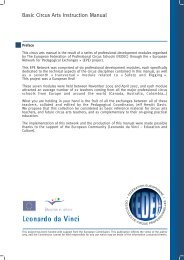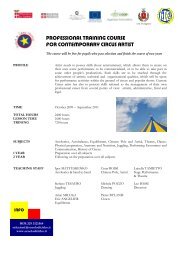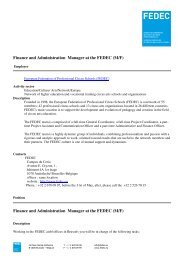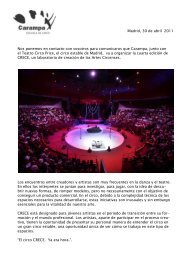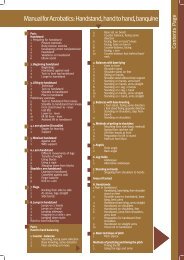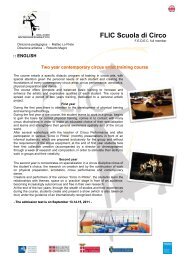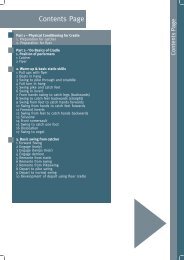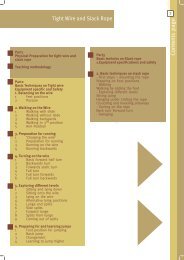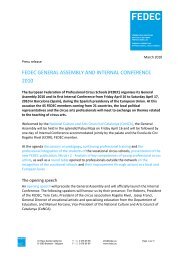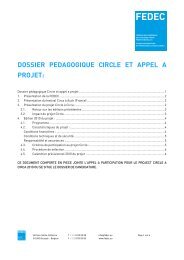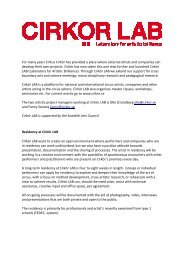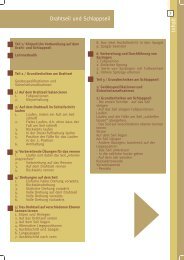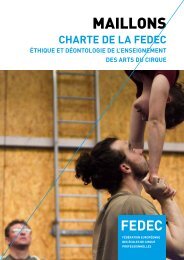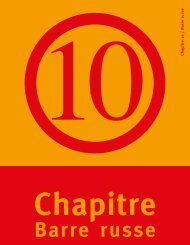InstructIon MAnuAL - Fedec
InstructIon MAnuAL - Fedec
InstructIon MAnuAL - Fedec
Create successful ePaper yourself
Turn your PDF publications into a flip-book with our unique Google optimized e-Paper software.
3<br />
specific physical<br />
conditioning<br />
the cyr wheel is an activity which puts a huge demand<br />
on the muscular and cardiovascular systems, when<br />
practised at a high level. the student’s initial physical<br />
condition, the length of the piece, its technical difficulty<br />
and density will determine the student’s specific aims in<br />
physical conditioning.<br />
Planning the specific conditioning used in the cyr wheel<br />
takes into consideration the following four ideas:<br />
– identifying energy systems<br />
– identifying the main muscular actions<br />
– identifying potential injury areas<br />
– identifying the antagonistic muscles<br />
in main movements<br />
IDEntIFyInG EnErGy systEMs<br />
a cyr wheel act generally lasts 4 to 8 minutes; it often<br />
has an uninterrupted movement and frequent variations<br />
of intensity which places a demand on the aerobic system.<br />
the anaerobic system is also under pressure during<br />
the whole act through the variation of repetitive muscular<br />
contractions and intensity during the performance. Both<br />
these systems should therefore be trained, in order to<br />
make the performance of a cyr wheel act easier.<br />
in concrete terms, indoor training could include aerobic<br />
work with short intervals (e.g. 30 seconds at 100% intensity<br />
and 30 seconds at 70% intensity) and uninterrupted<br />
(e.g. between 80% and 95% of the estimated maximum<br />
heart rate).<br />
During the discipline training we could specifically train<br />
these qualities by progressively repeating sequences of<br />
movements, with an increasing frequency, or, by repeating<br />
the act successive times in a row. this could be done<br />
nearer the time of the assessed performance.<br />
IDEntIFyInG thE MAIn MuscuLAr ActIons<br />
Generally speaking, the movements which are most often<br />
found in cyr wheel are holding a variety of body tension<br />
shapes (e.g. coins, basic steps, basic steps without<br />
legs…), leg pushes (e.g. jump into a pull up with straight<br />
arms, dish…) and arm pulling (e.g. climbing, flags …).<br />
these movements should be a priority in the goals of a<br />
conditioning/training programme.<br />
exercises performed in the weights room/gym should<br />
take into consideration these movements and body tension<br />
shapes and form part of the fundamental baselevel<br />
physical conditioning programme. likewise, the<br />
more physically challenging, technical cyr wheel moves<br />
performed by the students should also determine specific<br />
exercise selection, which should ultimately improve<br />
performance of the specific movements being trained in<br />
the discipline.<br />
For example, if a student chooses to do a basic step on<br />
his/her hands, a specific strength exercise for his/her<br />
shoulders could be included into the training programme.<br />
an example could be an endurance handstand exercise<br />
with hands set at a specific width.<br />
Some exercises can also be undertaken during technical<br />
training sessions’ movements. For example, for the<br />
basic step on hands, the student can be held in a handstand<br />
by the trainer, inside the wheel, in order to develop<br />
strength/endurance in his/her shoulders. Subsequently,<br />
forward and backwards tilting movements can be added<br />
to include the flexor/extensor muscle chains. once the<br />
student reaches sufficient levels of strength and endurance<br />
required to maintain these positions, the trainer can<br />
assist the basic step movement on the hands by guiding<br />
the rotation of the wheel like he/she does during the<br />
learning of the basic steps.<br />
48 CYR WHEEL © fedec 2011



